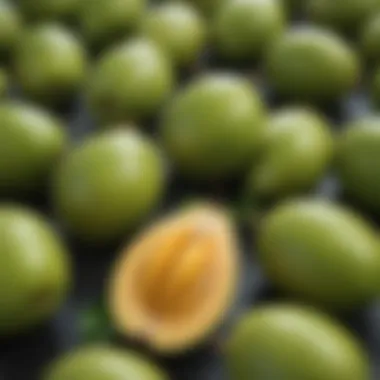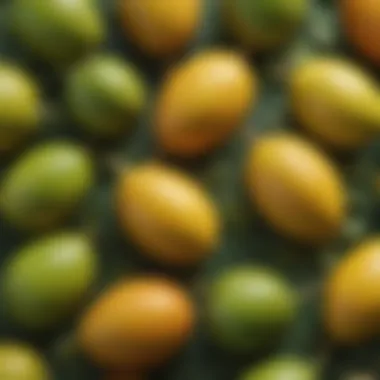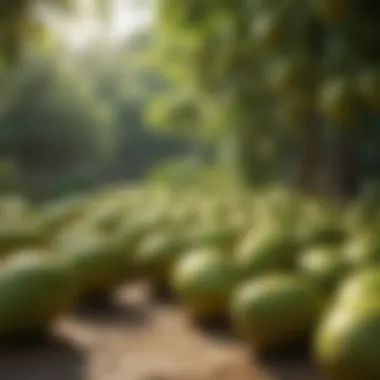Understanding Green Mango Pests: Identification and Management


Intro
Green mangoes are prized for their unique flavor and texture, making them a popular choice among gardeners and consumers alike. However, the cultivation of this fruit is often threatened by various pests that can severely impact yield and quality. Understanding these pests and learning effective management strategies is essential for any gardener, whether for personal enjoyment or commercial gain. This article provides insights into identifying common pest species associated with green mangoes, explores their life cycles, and offers integrated pest management techniques that are both effective and sustainable.
Understanding Pests
Definition of Pests
Pests are organisms that cause harm to plants, impacting their growth and productivity. In the case of green mangoes, these pests can range from insects to pathogens that compromise the health of the tree and its fruit. Their presence can lead to significant losses in production, which is a concern for both home gardeners and commercial growers.
Importance of Pest Identification
Correctly identifying pests is crucial for effective management. Each pest species may have unique characteristics and behaviors that influence their management methods. Failure to accurately identify the pest can lead to inappropriate treatment, which may exacerbate the problem. Understanding the specific pest can provide insights into its life cycle and feeding habits, enabling more targeted and timely interventions.
Prevention Techniques
Home and Garden Preventative Measures
To reduce the risk of pest infestations, gardeners should implement several preventative measures:
- Regular Inspection: Routinely check mango plants for signs of pests. Early detection can prevent serious issues later.
- Proper Sanitation: Clean up fallen fruit and leaves which can harbor pests.
- Healthy Practices: Maintain healthy plants through adequate watering and fertilization to ensure they are resilient against pests.
Seasonal Prevention Tips
Different pests may be more prevalent during specific times of the year. Some seasonal tips include:
- Spring: Monitor for signs of early infestations as the plants begin to grow.
- Summer: This is often peak pest season; implement insect netting as a barrier for young plants.
- Fall: Prepare plants for dormancy and remove any affected fruit or branches to reduce overwintering pests.
Eco-Friendly Pest Control Solutions
Overview of Sustainable Practices
Sustainable pest management focuses on minimizing chemical use and fostering natural ecosystem balance. Techniques include using resistant plant varieties and habitat enrichment for natural predators.
Natural Remedies and Their Effectiveness
Several natural remedies have proven effective in combating pests without harsh chemicals. Examples include:
- Neem Oil: This organic pesticide disrupts pest life cycles and deters them naturally.
- Diatomaceous Earth: A non-toxic powder that can be spread around plants; it damages the exoskeletons of insects that come into contact with it.
Important Note: Always test natural remedies on a small plant area first to ensure no harm comes to the plant.
Prolusion to Green Mango Pests
Mango cultivation plays a crucial role in agriculture, offering both economic and social benefits. As one of the most popular tropical fruits, mangoes contribute significantly to the livelihoods of farmers and the economy as a whole. However, this cultivation faces considerable challenges from pests that threaten the health of mango trees and the quality of their fruit. Understanding these pests is essential for both commercial growers and home gardeners to ensure a successful harvest.
The Importance of Mango Cultivation
Mangoes are not just a delicious fruit; they are vital to numerous economies across the world. Countries like India, Pakistan, and Mexico are among the leading producers of mangoes, generating income and employment opportunities for many. In addition to economic value, mango cultivation supports the diets of millions of people worldwide, providing essential nutrients. Protecting this vital crop from pests is essential to maintain its production levels, which makes understanding pest issues critical.
Overview of Pest Issues
Pest infestations can be devastating for mango farms, not only reducing yield but also compromising fruit quality. Various pests target different aspects of the mango plant, from roots to fruit. Identifying these pests early is crucial for implementing effective control strategies. Without proper management, infestations can lead to significant losses, making it imperative to be aware of the common pests affecting green mangoes.
Early detection and appropriate management strategies can mitigate the risks posed by pests. This article will explore the common pests, their identification, life cycles, and damage assessment. Additionally, integrated pest management strategies, alongside preventative measures will be discussed in detail, providing a comprehensive guide that aims to elevate mango farming practices.
Common Pests Affecting Green Mangoes
Understanding the common pests that affect green mangoes is crucial for sustaining healthy crops. Many pests can lead to serious consequences if not properly managed. Identifying these pests, understanding their behavior, and implementing management strategies can ensure not only the health of mango plants but also maximize yield. This section will delve into key pest species, providing insights crucial for both commercial growers and home gardeners.


Fruit Flies
Identification Features
Fruit flies are small pests, generally measuring 5 to 7 millimeters in length. They often have distinct yellow or brown body colors with black markings. One identification feature is their wings, which may have a characteristic pattern. Recognizing these features early on can significantly aid in pest control efforts. Their size and coloration make them easy to confuse with other insects, but their unique pattern can help distinguish them. Early identification can lead to rapid response, significantly benefiting mango cultivation.
Life Cycle
The life cycle of the fruit fly includes four stages: egg, larva, pupa, and adult. The female lays eggs in the fruit, and the larvae feed on the flesh of the mango. This life cycle means that fruit flies can multiply quickly, leading to larger infestations if not controlled timely. Understanding this cycle is essential as it informs the timing of control measures. With a short generation time, the risk of rapid population increase becomes evident. Knowing the life cycle enables growers to apply preventive measures before populations swell.
Damage Assessment
Assessing the damage caused by fruit flies involves examining the fruit for puncture marks and signs of decay. The damage includes reduced marketability and compromised fruit quality. Regular assessments can inform the extent of infestations and the effectiveness of management strategies. Early damage detection allows for timely intervention, which can help mitigate losses. Assessing damage also guides future pest management decisions, making it an integral part of the cultivation process.
Mango Leafhoppers
Behaviour Description
Mango leafhoppers are small, slender insects that often exhibit a distinctive hopping motion. They feed mainly on the sap of mango leaves, utilizing a needle-like mouthpart to extract nutrients. This behavior not only affects the plant's health but can also weaken its vigor. Understanding their behavior is important for choosing the right management strategies. Their feeding can lead to significant economic losses, hence its relevance in this article.
Signs of Infestation
Signs of mango leafhopper infestation include yellowing of leaves and stunted growth. Additionally, a sticky residue known as honeydew may be present due to their feeding. Recognizing these signs allows for early intervention. Infestations can lead to poor fruit quality, and this impacts the economic viability of mango production. Identifying signs promptly ensures that effective control measures can be implemented.
Impact on Crop Health
Mango leafhoppers can have considerable negative effects on overall crop health. Infestations often lead to reduced photosynthesis and weakened plants, making them more susceptible to other diseases. Understanding these impacts can guide growers in applying integrated pest management strategies that enhance crop resilience. Alertness to their impact is key, as failing to manage these pests can lead to long-term implications for the mango orchard’s health.
Scale Insects
Identification Techniques
Scale insects are often difficult to spot due to their small size and protective coverings. Growers can identify them by the waxy scales that often adhere to the bark or leaves. Observing for these features allows for early detection and intervention. This technique is essential as the damage they cause can go unnoticed until significant harm has already occurred. Identifying these insects timely helps in planning effective control measures.
Feeding Damage
Feeding damage by scale insects manifests as yellowing leaves or reduced growth. These pests extract sap, weakening the plant over time. Understanding the extent of feeding damage is critical for pest management planning. If not managed properly, scale insects can lead to substantial declines in crop yield. Regularly assessing feeding damage informs growers about pest pressures they may need to address.
Reproductive Characteristics
Scale insects can reproduce in high numbers, often producing multiple generations per season. This characteristic can lead to outbreaks if left unchecked. Understanding their reproductive patterns can inform management strategies, allowing growers to combat infestations effectively. The high reproductive rate presents both challenges and opportunities for pest control, making it a vital aspect for consideration.
Mealybugs
Identification and Symptoms
Mealybugs present as soft-bodied insects covered in a white, waxy secretion. They are commonly found in clusters on various parts of mango plants, especially on the stems and undersides of leaves. Identifying them early is crucial to effective management, as symptoms may include wilting leaves and reduced growth. Recognizing these symptoms quickly can help prevent full infestations. Mealybugs can damage plants significantly, disrupting growth and fruit production.
Control Measures
Management of mealybug populations involves several strategies, including chemical applications and natural predators. Using insecticidal soap or horticultural oils can effectively manage infestations. Additionally, introducing beneficial insects like ladybugs can provide long-term control. Implementing these measures early is beneficial as resistant populations may develop over time. Control measures tailored for mealybugs significantly enhance the success of pest management efforts.
Biological Control Agents
Utilizing biological control agents, such as parasitic wasps, can play a significant role in reducing mealybug populations. These agents target mealybugs specifically and can be a crucial part of an integrated pest management strategy. Understanding their role helps growers recognize the potential benefits of natural controls. While effective, relying solely on biological agents may take longer to see results, so it’s vital to combine them with other management strategies.
Life Cycle of Common Green Mango Pests
The life cycle of pests is a crucial element in understanding their behavior and impact on green mango cultivation. Knowing how different pests develop through their life stages helps in effective identification and management strategies. Each stage of a pest's life cycle can present unique challenges, and recognizing these can help in implementing timely interventions.


Understanding Pest Life Cycles
Every pest has a distinct life cycle that typically includes stages such as egg, larva, pupa, and adult. For example, fruit flies lay eggs on the ripening mangoes. The larvae emerge and feed on the fruit, causing significant damage. Similarly, the life cycle of mango leafhoppers includes laying eggs on leaves, where the immature stages carry out feeding activities that can cause leaf curling and reduced growth.
Understanding these stages allows gardeners to identify the most vulnerable phases for control. The more one knows about the pest's life cycle, the better one can time cultural and chemical management methods to maximize effectiveness. Monitoring tools can track life stages, guiding when to apply pesticides or introduce biological controls.
Seasonal Patterns of Infestation
Pests often exhibit seasonal patterns, making some times of the year more critical than others for monitoring and management. For instance, many pests thrive in warm conditions, increasing their activities during the dry season. During this time, populations can grow rapidly, leading to heightened risks of infestation.
- Key Patterns to Observe:
- Temperature Effects: Higher temperatures can accelerate pest development, thus higher populations during specific months.
- Rain Impact: Increased moisture can also promote certain pests while deterring others.
By being aware of these patterns, home gardeners can adopt a proactive approach. Understanding when pests are likely to be most active enables early detection strategies, which are vital for protecting not just the yield but the health of the mango trees.
"Effective pest management is rooted in understanding pest life cycles and their seasonal behaviors. This knowledge allows for timely responses tailored to the life stage of the pest."
In summary, comprehending the life cycle and seasonal patterns of green mango pests is integral to developing effective management strategies. Knowing when and how pests reproduce or feed leads to better decision-making in pest control operations.
Integrated Pest Management Strategies
Integrated Pest Management, or IPM, is a multifaceted approach used to effectively manage pest populations while minimizing environmental impacts. This method is particularly relevant to mango cultivation, given the distinct vulnerabilities of green mangoes to various pests. IPM combines different techniques to optimize pest control while addressing economic and ecological considerations. By integrating cultural, chemical, and biological strategies, farmers can promote healthier crops and sustainable practices.
Cultural Practices
Crop Rotation
Crop rotation involves alternating the types of crops grown in a particular area across different seasons. This tactic disrupts the life stages of pests that thrive in specific crops. Crop rotation is popular because it reduces the build-up of pest populations and improves soil fertility. The key characterstic of this practice is its ability to manage pests without the use of chemicals. The unique feature of crop rotation is that it leverages natural processes, ultimately decreasing dependency on pesticides. One disadvantage, however, is the possible complexity it adds to planning planting schedules.
Sanitation Measures
Sanitation measures play a critical role in pest management. Keeping the mango farm clean minimizes potential breeding grounds for pests. The main characteristic of sanitation measures is their preventative nature; it aims to reduce pest presence before infestations start. This is beneficial as it lowers the need for intensive management later on. The unique aspect of sanitation is that it often includes simple tasks like removing debris and fallen fruit, which can harbor pests. A downside is that it requires consistent effort from farmers to maintain the necessary maintenance practices.
Monitoring and Early Detection
Monitoring and early detection are essential for successful pest management. Regular field observations help identify pest outbreaks before they escalate. Farmers who implement monitoring practices can make informed decisions quickly. Early detection channels resources towards targeted management actions, ultimately improving outcomes for mango health and yield. To effectively monitor pests, using traps and visual checks can provide important data.
Chemical Control Options
Choosing the Right Pesticides
Selecting the right pesticides is crucial for minimizing harm to beneficial organisms while effectively controlling pest populations. The main characteristic of choosing appropriate pesticides lies in understanding product ingredients and their specific effects. This method is beneficial because it allows for targeted interventions that adhere to safety regulations. The unique feature of this choice is the increasing availability of eco-friendly products. However, over-reliance on any chemical can lead to resistance and diminishing effectiveness if not used judiciously.
Application Techniques
Effective application techniques are necessary for maximizing the efficacy of pesticides. Techniques range from proper calibration of spray equipment to understanding application timing. An important aspect of these techniques is that they can significantly impact the distribution of pesticides and the degree of pest control achieved. Beneficial choices in application methods include utilizing integrated equipment that minimizes drift and runoff. Yet, one downside is that improper techniques can lead to wasted resources and increased environmental exposure.
Biological Control Methods
Predators and Parasitoids
Biological control employs natural enemies of pests to manage populations effectively. This approach can be beneficial as it reduces dependency on chemical methods and promotes ecological balance. A key characteristic of using predators and parasitoids is their capacity to target specific pest species. The unique feature is their ability to establish populations that can manage pest levels naturally. A disadvantage includes the potential for delays in effectiveness, as establishing natural enemies requires time.
Utilizing Natural Competitors
Utilizing natural competitors involves encouraging species that compete for resources or habitat with target pests. This strategy can lead to lower pest populations in a sustainable manner. The main characterstic of this method is its reliance on biodiversity to manage pests, making it a sustainable approach. This practice provides a long-term solution without chemical inputs. However, one potential downside is that it may not immediately impact pest populations, thus requiring patience and careful planning.
Preventative Measures for Mango Pests


Preventative measures play a crucial role in the management of pests impacting green mangoes. These strategies not only reduce the likelihood of infestation but also promote overall plant health, leading to enhanced fruit quality and yield. Implementing preventative tactics is often more cost-effective than dealing with large-scale pest outbreaks. Careful planning and attention to cultivation practices can significantly diminish potential damage from pests.
Best Practices in Mango Cultivation
Cultivating green mangoes requires attention to best practices that contribute to healthier plants and lower pest populations.
- Proper Plant Spacing: Adequate space between trees ensures good air circulation. This reduces humidity levels that are favorable for pests and diseases.
- Regular Pruning: Trimming excessive foliage keeps trees healthy and encourages better light penetration, reducing hiding spots for pests.
- Companion Planting: Introducing specific companion plants can deter pests naturally. For instance, marigolds are known to repel nematodes and other insects.
- Monitoring: Regularly inspect trees for early signs of pest activity. Use sticky traps to capture pests and assess their population levels regularly.
These practices create an environment that is less conducive to pest proliferation.
Importance of Soil Health
Soil health is fundamental to any successful agriculture. A thriving root system supports the overall vigor of the mango trees. Healthy soil contributes to stronger plants, which can better resist pest pressures.
- Nutrient Management: Conduct soil tests to determine nutrient levels and amendments needed. A balanced nutrient profile fosters strong plant growth.
- Organic Matter: Adding compost increases beneficial microorganisms and improves soil structure. This supports root health and enhances water retention.
- Mulching: Applying organic mulch around the base of trees helps retain moisture, suppress weeds, and provide habitat for beneficial insects that prey on harmful pests.
Economic and Ecological Considerations
Understanding the economic and ecological aspects of green mango pest management is crucial for both commercial growers and home gardeners. While mango cultivation represents a significant source of income, it is increasingly challenged by various pest species. Addressing these pest issues not only influences yield but also impacts the overall economics of mango farming.
Pests can lead to considerable reductions in fruit yield and quality. For instance, infestations from fruit flies can render mangoes unmarketable. This ultimately affects the profitability of growers. On the other hand, certain pest management strategies can be costly. Therefore, the challenge lies in finding a balance between effective pest control methods and maintaining economic viability.
In addition to financial implications, the ecological considerations cannot be overlooked. Sustainable pest management practices are vital for preserving biodiversity. Over-reliance on chemical pesticides may cause ecological imbalances, harming beneficial insects and the broader ecosystem. By implementing integrated pest management strategies, including biological controls and cultural practices, growers can protect mango crops while minimizing negative impacts on their environment.
"Maintaining ecosystem health while managing pests is essential for sustainable agriculture."
Adopting sustainable practices not only protects the immediate environment but also enhances the long-term health of mango cultivation. This results in a symbiotic relationship between economic viability and ecological integrity.
Impact of Pests on Mango Yield
The impact of pests on mango yield is profound. Various pests can attack both the fruits and foliage, leading to significant declines in production. For instance, the presence of fruit flies generally results in a high rate of fruit drop and egg-laying, which directly translates to lower fruit numbers available for harvest. Furthermore, the damage from leafhoppers decreases the overall health of the tree, reducing its ability to produce fruit.
The following impacts are typically observed due to pest infestations:
- Direct Damage: Infestation leads to visible damage on the fruits, which can result in disqualification from market sales.
- Reduced Growth: Pests can sap nutrient resources from trees, leading to stunted growth and delayed fruit production.
- Increased Input Costs: Intensive management strategies in response to infestations can increase overall costs.
Prevention and early identification are essential to mitigate these impacts. Gardening practices that promote healthy trees can significantly diminish pest-related damage.
Balancing Pest Control with Ecosystem Health
Balancing pest control with ecosystem health involves careful consideration of the methods employed in managing pest populations. While immediate action is often necessary to combat infestations, the long-term effects of those actions on the environment should be carefully evaluated. For example, while chemical pesticides can provide quick results in pest control, they may also harm beneficial insect populations, disrupt soil health, and contaminate water sources.
Effective strategies to maintain this balance include:
- Using Integrated Pest Management: This approach combines biological, cultural, and chemical methods. By emphasizing natural pest predators and minimizing chemical use, the balance can be maintained.
- Implementing Crop Diversity: Planting a variety of crops alongside mangoes can deter pests and strengthen the ecosystem's resilience.
- Educating Growers on Sustainable Practices: Awareness programs can help inform about the importance of maintaining healthy ecosystems.
In summary, focusing on the relationship between economic viability and ecological health is essential for sustainable mango cultivation. Addressing the challenges presented by pests should be done in a manner that promotes both productivity and environmental integrity. The future of mango farming depends on these balanced approaches.
Ending and Future Perspectives
The section of conclusion presents not only a recap of the key findings but also emphasizes the future outlooks of managing green mango pests. Understanding these pests is essential for maintaining healthy crops and ensuring sustainable practices in mango farming. Effective management strategies can lead to significant improvements in both yield and quality of the fruit. Moreover, this article highlights the importance of integrating various pest management techniques tailored for different scenarios and environments.
As readers digest the provided information, they should reflect on the interconnectedness of pest management and ecological balance. Proper identification and management of pests can mitigate losses, allowing for healthier mango production. Households and gardens will benefit from these insights, as informed decisions will create more fruitful outcomes.
Summation of Key Points
- Green mango pests pose a serious threat to production and yield.
- Identification of pests such as fruit flies, leafhoppers, scale insects, and mealybugs is crucial for effective management.
- Understanding the life cycles of pests helps in predicting infestations.
- Integrated pest management (IPM) strategies incorporate cultural practices, monitoring, and biological methods, making them more sustainable.
- The economic impact of pest infestations underscores the need for proactive measures in mango cultivation.
Ongoing Research and Innovations
The field of pest management is ever evolving. Ongoing research looks into new methods and tools for identifying pests early and controlling them effectively. This includes the use of technological innovations such as remote sensing and data analytics to monitor pest populations and environmental conditions.
Furthermore, researchers are exploring advanced biological controls. Natural predators and microbial applications are gaining traction as effective means of managing pests without harming the ecosystem. There is a growing emphasis on creating pest-resistant mango varieties through genetic research.
Also, platforms like Reddit and Facebook have communities sharing knowledge and experience. These are valuable resources for both amateur and professional mango cultivators to stay updated on the latest trends and innovations.
Ultimately, the future of green mango pest management relies not only on current practices but also on embracing new technologies and methodologies. This commitment to research leaves room for improved strategies that cater to the unique challenges presented by pests in mango farming.



